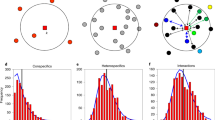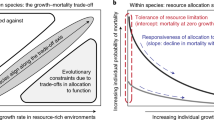Abstract
Contemporary acceleration of biodiversity loss makes increasingly urgent the need to understand the controls of species coexistence1,2. Tree diversity in particular plays a pivotal role in determining terrestrial biodiversity, through maintaining diversity of its dependent species3,4 and with them, their predators and parasites. Most theories of coexistence based on the principle of limiting similarity suggest that coexistence of competing species is inherently unstable; coexistence of competitors must be maintained by external forces such as disturbance5,6, immigration7 or ‘patchiness’ of resources in space and time8,9. In contrast, storage theory postulates stable coexistence of competing species through temporal alternation of conditions favouring recruitment of one species over the other10,11. Here we use storage theory to develop explicit predictions for relative differences between competitors that allow us to discriminate between coexistence models. Data on tree species from a primary forest on the Mexican Pacific coast support a general dynamic of storage processes determining coexistence of similar tree species in this community, and allow us to reject all other theories of coexistence.
This is a preview of subscription content, access via your institution
Access options
Subscribe to this journal
Receive 51 print issues and online access
$199.00 per year
only $3.90 per issue
Buy this article
- Purchase on Springer Link
- Instant access to full article PDF
Prices may be subject to local taxes which are calculated during checkout



Similar content being viewed by others
References
May, R. M., Lawton, J. H. & Stork, N. E. in Extinction Rates (eds Lawton, J. H. & May, R. M.) 1–24 (Oxford Univ. Press, Oxford, 1995)
Tilman, D. Causes, consequences and ethics of biodiversity. Nature 405, 208–211 (2000)
May, R. M. How many species are there on Earth? Science 241, 1441–1449 (1988)
Kelly, C. K. & Southwood, T. R. E. Species richness and resource availability: a phylogenetic analysis of insects associated with trees. Proc. Natl Acad. Sci. USA 96, 8013–8016 (1999)
Hutchinson, G. E. Homage to Santa Rosalia, or Why are there so many kinds of animals? Am. Nat. 93, 145–159 (1959)
Connell, J. H. Diversity in tropical rainforests and coral reefs. Science 199, 1302–1310 (1978)
Hubbell, S. P. The Unified Neutral Theory of Biodiversity and Biogeography (Princeton Univ. Press, Princeton, 2001)
Nee, S. & May, R. M. Dynamics of metapopulations: habitat destruction and competitive coexistence. J. Anim. Ecol. 61, 37–40 (1992)
Pacala, S. W. & Tilman, D. Limiting similarity in mechanistic and spatial models of plant competition in heterogeneous environments. Am. Nat. 143, 222–257 (1994)
Chesson, P. L. & Warner, R. R. Environmental variability promotes coexistence in lottery competitive systems. Am. Nat. 117, 923–943 (1981)
Chesson, P. L. & Huntly, N. Short-term instabilities and long-term community dynamics. Trends Ecol. Evol. 4, 293–298 (1989)
MacArthur, R. H. & Levins, R. The limiting similarity, convergence and divergence of coexisting species. Am. Nat. 101, 377–385 (1967)
Tilman, D. Plant Strategies and the Dynamics and Structure of Plant Communities (Princeton Univ. Press, Princeton, 1988)
Kelly, C. K. et al. Investigations in commonness and rarity: a comparison of size distributions of co-occurring, congeneric Mexican trees. Ecol. Lett. 4, 618–627 (2001)
Chesson, P. L. Mechanisms of maintenance of species diversity. Annu. Rev. Ecol. Syst. 31, 343–366 (2000)
Warner, R. R. & Chesson, P. L. Coexistence mediated by recruitment fluctuations: a field guide to the storage effect. Am. Nat. 125, 769–787 (1985)
Herms, D. A. & Mattson, W. J. The dilemma of plants: to grow or defend. Q. Rev. Biol. 67, 283–335 (1992)
Harvey, P. H. & Pagel, M. D. The Comparative Method in Evolutionary Biology (Oxford Univ. Press, Oxford, 1991)
Harvey, P. H. Phylogenies for ecologists: the 1995 Tansley Lecture. J. Anim. Ecol. 65, 255–263 (1996)
Pagel, M. D. A method for the analysis of comparative data. J. Theor. Biol. 156, 431–442 (1992)
Siegal, S. Nonparametric Statistics (McGraw-Hill, New York, 1956)
Condit, R., Sukumar, R., Hubbell, S. P. & Foster, R. B. Predicting population trends from size distributions: a direct test in a tropical community. Am. Nat. 152, 495–509 (1998)
Chesson, P. Multispecies competition in variable environments. Theor. Popul. Biol. 45, 227–276 (1994)
MacArthur, R. H. On the relative abundance of bird species. Proc. Natl Acad. Sci. USA 43, 293–295 (1957)
Woodward, F. I. & Kelly, C. K. in Plant Functional Types (eds Smith, T. M., Shugart, H. H. & Woodward, F. I.) (Cambridge Univ. Press, Cambridge, 1997)
Rees, M., Condit, R., Crawley, M., Pacala, S. & Tilman, D. Long-term studies of vegetation dynamics. Science 293, 650–655 (2001)
Lott, E. J. Annotated checklist of the vascular plants of the Chamela Bay region, Jalisco, México. Occas. Pap. Calif. Acad. Sci. 148, 1–60 (1993)
Rzedowski, J. Vegetación de México (Limusa, México DF, México, 1978)
Lusk, C. H. & Smith, B. Life history differences and tree species coexistence in an old-growth New Zealand rain forest. Ecology 79, 795–806 (1998)
Becerra, J. X. & Venable, D. L. Nuclear ribosomal DNA phylogeny and its implications for evolutionary trends in Mexican Bursera (Burseraceae). Am. J. Bot. 86, 1047–1057 (1999)
Acknowledgements
We thank F. I. Woodward, P. Doncaster, P. Harvey, M. Fenner and P. Chesson for comments. This work was supported by grants to C.K.K. from the US-Mexico Foundation for Science, the Earthwatch Foundation and the National Geographic Society. C.K.K. thanks Merton College for a visiting research fellowship during the initiation of this project.
Author information
Authors and Affiliations
Corresponding author
Ethics declarations
Competing interests
The authors declare that they have no competing financial interests.
Rights and permissions
About this article
Cite this article
Kelly, C., Bowler, M. Coexistence and relative abundance in forest trees. Nature 417, 437–440 (2002). https://doi.org/10.1038/417437a
Received:
Accepted:
Issue Date:
DOI: https://doi.org/10.1038/417437a
This article is cited by
-
Disentangling the Legacies of Climate and Management on Tree Growth
Ecosystems (2022)
-
Diversity and biomass of different functional groups of herbaceous species along an altitudinal gradient in the semi-arid Zagros mountain forests of Iran
Journal of Forestry Research (2020)
-
Managing tree species diversity and ecosystem functions through coexistence mechanisms
Annals of Forest Science (2018)
-
Extinction debt and colonization credit delay range shifts of eastern North American trees
Nature Ecology & Evolution (2017)
-
Temporal niche promotes biodiversity during adaptive radiation
Nature Communications (2013)
Comments
By submitting a comment you agree to abide by our Terms and Community Guidelines. If you find something abusive or that does not comply with our terms or guidelines please flag it as inappropriate.



